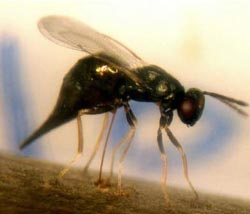Chinese wasps are taking on the emerald ash borer

Tetrastichus planipennisi is a parasitoid wasp used to control the emerald ash borer.<br><br>Credit: USDA Forest Service<br>
The emerald ash borer (EAB), a relatively new invasive insect pest, has killed tens of millions of ash trees throughout the eastern United States since it was first detected in 2002 in Michigan and Canada. This insect has the potential to kill an estimated seven billion ash trees in urban and rural forests and could cause tens of billions of dollars in damage.
To control the EAB, research on its natural enemies was initiated shortly after its discovery, resulting in a classical biological control program using three parasitoid wasps native to northern China, where the EAB populations in the US likely originated. After research on the biology, laboratory rearing, and host specificity of the three parasitoid species was completed in 2007, federal and state regulatory agencies approved their environmental release in more than a dozen states.
In an article appearing in the June issue of the Journal of Economic Entomology called “Establishment and Abundance of Tetrastichus planipennisi (Hymenoptera: Eulophidae) in Michigan: Potential for Success in Classical Biocontrol of the Invasive Emerald Ash Borer (Coleoptera: Buprestidae),” the authors observed one of the species, Tetrastichus planipennisi Yang, and found that the populations of these parasitoid wasps have been increasing and expanding in Michigan, which suggests that they will likely play a critical role in suppressing the EAB in that state.
These tiny wasps, which do not sting humans, lay eggs into or on the EAB larvae.
The researchers sampled trees for wasp broods at six forest sites near Lansing, Michigan. By the fall of 2012, the proportion of sampled trees with one or more broods of T. planipennisi increased from 33% to 92% in the plots where the wasps were released. Similarly, the rates of parasitism on the EAB increased from 1.2% in the first year after the parasitoid releases to 21.2%.
Journalists who would like an advanced copy of the article should request one by writing to pubs@entsoc.org or calling 301-731-4535, ext 3009.
DOI: http://dx.doi.org/10.1603/EC13047
The Journal of Economic Entomology is published by the Entomological Society of America (ESA), the largest organization serving the professional and scientific needs of entomologists and people in related disciplines in the world. Founded in 1889, ESA today has more than 6,000 members affiliated with educational institutions, health agencies, private industry, and government. Members are students, researchers, teachers, extension service personnel, administrators, marketing representatives, consultants, and hobbyists. For more information, please visit http://www.entsoc.org.
Media Contact
More Information:
http://www.entsoc.orgAll latest news from the category: Agricultural and Forestry Science
Newest articles

Security vulnerability in browser interface
… allows computer access via graphics card. Researchers at Graz University of Technology were successful with three different side-channel attacks on graphics cards via the WebGPU browser interface. The attacks…

A closer look at mechanochemistry
Ferdi Schüth and his team at the Max Planck Institut für Kohlenforschung in Mülheim/Germany have been studying the phenomena of mechanochemistry for several years. But what actually happens at the…

Severe Vulnerabilities Discovered in Software to Protect Internet Routing
A research team from the National Research Center for Applied Cybersecurity ATHENE led by Prof. Dr. Haya Schulmann has uncovered 18 vulnerabilities in crucial software components of Resource Public Key…





















